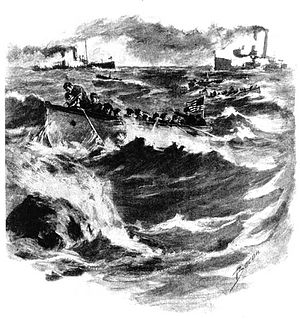Battle of Cienfuegos
| Battle of Cienfuegos | |||||||
|---|---|---|---|---|---|---|---|
| Part of the Spanish–American War | |||||||
 The cable-cutting expedition at Cienfuegos, Bacon | |||||||
| |||||||
| Belligerents | |||||||
|
|
| ||||||
| Commanders and leaders | |||||||
|
|
| ||||||
| Strength | |||||||
| Unknown |
1 unprotected cruiser 1 gunboat 1 revenue cutter 2 steam launches[2] | ||||||
| Casualties and losses | |||||||
| None |
2 killed 15 wounded | ||||||
The Battle of Cienfuegos, also known as the Raid on Cienfuegos, was an engagement of the Spanish–American War, intended by the United States Navy to tighten its blockade of Cuba.[3]
Background
[edit]The Spanish were using undersea cables as a means to communicate with not only the rest of Cuba, but also the Spanish command. These cables had many key junctions, namely, a shore near Cienfuegos. The cables connected to Havana, the port of Santiago, and then branched off to other Caribbean islands such as Jamaica. The cables were run out from an easily located house which contained a critical hub for the undersea cable system. While the house could easily be destroyed, this would only inflict largely superficial damage, and could easily be repaired and functioning in a short period of time. Therefore, command decided to grapple the three cables out of the sea and cut them in several places, disrupting much of the communications between the Spanish and their operations in Cuba. This damage would be much more difficult to repair, as the cables were nearing two inches in diameter which made cutting, and by extension repairing them, a difficult task. For the mission, the cruiser USS Marblehead, the gunboat USS Nashville, and the revenue cutter USS Windom[2]: 72 were dispatched under the command of Captain Bowman H. McCalla to sever them.[3][4]
Battle
[edit]
The Marblehead and Nashville both opened fire on the cable house at 6:45 a.m. on May 11, 1898. Rather quickly, the cable house collapsed from the fire from the two warships. Ten minutes later, at 6:55 a.m. the warships dispatched their work boats, each carrying a minimal crew of sixteen, in order to minimize the risk of casualty. The element of surprise was quickly lost, as a Spanish Cavalryman spotted the ships en route to the beach.
While the first cable was out of the line of fire, the second cable was not so easy to cut. Because of coral formation, the cable was very difficult to snare in order to bring it up to the surface and cut. The Spanish forces were also much closer to the second cable, so the crew had to contend with both of these problems. In order to suppress the increased fire from the Spanish forces, both warships increased their bombardment. As the raid crew hauled up the second cable to cut it, they discovered a third, smaller cable. After the second had been cut, they moved on to find this third and final cable. They were not able to however, as a large contingent of Spanish forces arrived from Cienfuegos to repel what they thought at the time was a full-scale invasion. By 11:15 a.m. the raid was over.

After a tense, hour-long firefight, two cables were cut, and the sailors and Marines withdrew, but a third cable near the shore remained untouched.[5]
Aftermath
[edit]Fifty-two US sailors and marines were awarded the Medal of Honor for "setting an example of extraordinary bravery and coolness under fire."[6]
References
[edit]- ^ "Historia Naval de España y Países de habla española. - Ver Tema - 1898. Hasta el último hombre".
- ^ a b Nofi, A.A., 1996, The Spanish–American War, 1898, Pennsylvania: Combined Books, ISBN 0938289578
- ^ a b "Spanish–American War: Raid on Cienfuegos". Historynet. 21 August 2006. Retrieved 16 January 2013.
- ^ Pelzer, John (1993). "False invasion repelled (Raid on Cienfuegos, 1898)". British Heritage. Military History. ISSN 0889-7328.
- ^ Smith, Joseph (1995). The Spanish–American War: Conflict in the Caribbean and the Pacific, 1895–1902. London; New York : Longman, 1995.
- ^ "Medal of Honor Recipients - War With Spain". Archived from the original on 2013-09-17.
